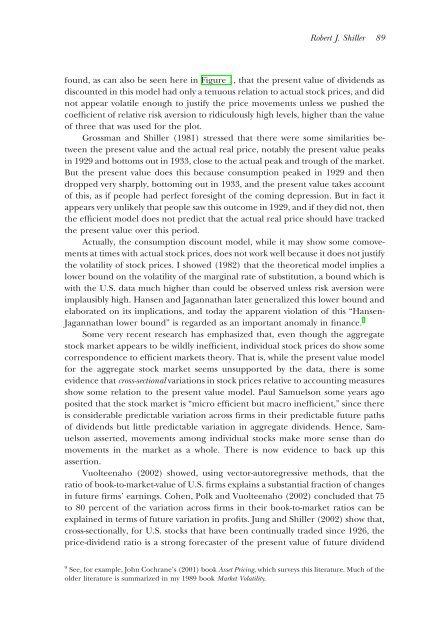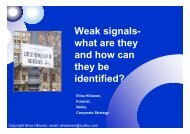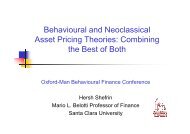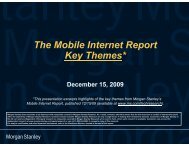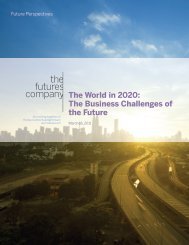From Efficient Markets Theory to Behavioral Finance
From Efficient Markets Theory to Behavioral Finance
From Efficient Markets Theory to Behavioral Finance
You also want an ePaper? Increase the reach of your titles
YUMPU automatically turns print PDFs into web optimized ePapers that Google loves.
Robert J. Shiller 89<br />
found, as can also be seen here in Figure 1, that the present value of dividends as<br />
discounted in this model had only a tenuous relation <strong>to</strong> actual s<strong>to</strong>ck prices, and did<br />
not appear volatile enough <strong>to</strong> justify the price movements unless we pushed the<br />
coefficient of relative risk aversion <strong>to</strong> ridiculously high levels, higher than the value<br />
of three that was used for the plot.<br />
Grossman and Shiller (1981) stressed that there were some similarities between<br />
the present value and the actual real price, notably the present value peaks<br />
in 1929 and bot<strong>to</strong>ms out in 1933, close <strong>to</strong> the actual peak and trough of the market.<br />
But the present value does this because consumption peaked in 1929 and then<br />
dropped very sharply, bot<strong>to</strong>ming out in 1933, and the present value takes account<br />
of this, as if people had perfect foresight of the coming depression. But in fact it<br />
appears very unlikely that people saw this outcome in 1929, and if they did not, then<br />
the efficient model does not predict that the actual real price should have tracked<br />
the present value over this period.<br />
Actually, the consumption discount model, while it may show some comovements<br />
at times with actual s<strong>to</strong>ck prices, does not work well because it does not justify<br />
the volatility of s<strong>to</strong>ck prices. I showed (1982) that the theoretical model implies a<br />
lower bound on the volatility of the marginal rate of substitution, a bound which is<br />
with the U.S. data much higher than could be observed unless risk aversion were<br />
implausibly high. Hansen and Jagannathan later generalized this lower bound and<br />
elaborated on its implications, and <strong>to</strong>day the apparent violation of this “Hansen-<br />
Jagannathan lower bound” is regarded as an important anomaly in finance. 9<br />
Some very recent research has emphasized that, even though the aggregate<br />
s<strong>to</strong>ck market appears <strong>to</strong> be wildly inefficient, individual s<strong>to</strong>ck prices do show some<br />
correspondence <strong>to</strong> efficient markets theory. That is, while the present value model<br />
for the aggregate s<strong>to</strong>ck market seems unsupported by the data, there is some<br />
evidence that cross-sectional variations in s<strong>to</strong>ck prices relative <strong>to</strong> accounting measures<br />
show some relation <strong>to</strong> the present value model. Paul Samuelson some years ago<br />
posited that the s<strong>to</strong>ck market is “micro efficient but macro inefficient,” since there<br />
is considerable predictable variation across firms in their predictable future paths<br />
of dividends but little predictable variation in aggregate dividends. Hence, Samuelson<br />
asserted, movements among individual s<strong>to</strong>cks make more sense than do<br />
movements in the market as a whole. There is now evidence <strong>to</strong> back up this<br />
assertion.<br />
Vuolteenaho (2002) showed, using vec<strong>to</strong>r-au<strong>to</strong>regressive methods, that the<br />
ratio of book-<strong>to</strong>-market-value of U.S. firms explains a substantial fraction of changes<br />
in future firms’ earnings. Cohen, Polk and Vuolteenaho (2002) concluded that 75<br />
<strong>to</strong> 80 percent of the variation across firms in their book-<strong>to</strong>-market ratios can be<br />
explained in terms of future variation in profits. Jung and Shiller (2002) show that,<br />
cross-sectionally, for U.S. s<strong>to</strong>cks that have been continually traded since 1926, the<br />
price-dividend ratio is a strong forecaster of the present value of future dividend<br />
9 See, for example, John Cochrane’s (2001) book Asset Pricing, which surveys this literature. Much of the<br />
older literature is summarized in my 1989 book Market Volatility.


